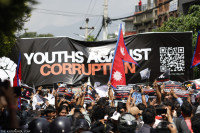Opinion
Diagnosing governance
Despite commitments from political parties and successive governments, the state of governance remains poor
LS Ghimire
Efforts for administrative reform, sometimes used as a synonym for governance reform, have an official history of more than six decades—the first Administrative Reform Commission was formed in 1951 but a dedicated Action Plan on Governance was only adopted by the government in 2010, followed by an Immediate Action Plan on Economic and Governance Reform in 2012. However, the implementation of these action plans could not take pace. On the one hand, reports and recommendations from about half a dozen commissions have never been implemented and on the other, the government continues with a kind of permanent administrative committee.
What went wrong?
The ground situation, meanwhile, is a mess. Pipes do not deliver water; electricity disappears for more than 12 hours a day; the roads are filled with potholes; waste silently kills many; adulteration is rampant; denizens of the Capital are getting deaf due to noise pollution; and overnight queuing stretch in front of the Department of Passport and the Department of Foreign Employment. The list could go on and on.
What is wrong then? First, there has never been political stability. Stability further worsened during the conflict period. Additionally, successive governments saw governance reform only as a means to gain popularity while it needed to be seen as long-term process. Second, both leaderships—the political and bureaucratic—kept promising governance reform but failed to make a demonstrable commitment. In the meantime, the bureaucracy too got heavily politicised. The general widespread perception is that civil servants up to the section officer level have been working as sister concerns of the political parties, though they have the right to form a union. Similarly, the perception of the Joint Secretary level is that unless they obtain a certain kind of identity or membership card, they will not get a chance to be a Secretary- a position that everyone in the civil service dreams of.
No matter how many ministries we have, they are all equally important. However, both politicians and civil servants have categorised them as ‘lucrative’ and ‘non-lucrative’. Such categorisation has prompted politicians to choose hamro manchhe (their people) as secretaries while those in the civil service also use their muscle to join ‘lucrative’ ministries. Viewed from this perspective, only one level of the bureaucracy—the under-secretary—appears apolitical. And a single level cannot drive governance reform.
A lack of clarity
Governance reform requires a deep understanding of development as well as the administrative issues faced by Nepalis. Unfortunately, we are accustomed to being influenced by donor prescriptions, which keep changing to avoid possible criticisms for their failures because of such non-contextualised prescriptions in the first place. Furthermore, we never seem to assess where we are, never think about where we intend to reach and rarely analyze the gaps between the two. In other words, at no level is there a willingness to address problems.
Another related issue is the lack of a clear statement of the path to follow for Nepal’s development, which is to be developed in consultation with stakeholders. Local bodies are absent. The planning authority—the National Planning Commission (NPC)—remains dysfunctional most of the time due to political instability. Some four decades back, Professor Aaron Wildavsky wrote an article on why planning fails in Nepal. In his article, Wildavsky, blamed the rivalry between the NPC and the Ministry of Finance, and the lack of coordination in planning. All of this continues today as well.
Yet another issue is the number of governments in Nepal. One might think it absurd to say that is more than one government in Nepal but this is true. Even if one does not consider constitutional bodies, each ministry acts as if it were the government. In other words, there are as many governments as there are ministries, all of whom work independently. There is no thinking of a ‘whole government’ approach, where there would be specific organisations with a clear mandate and strong political support to drive changes and track progress. Currently, one ministry disapproves of another’s initiative. This lack of coordination, if not a feeling of supremacy, is clearly seen in Kathmandu’s ongoing road expansion. The road authority comes alone, finishes its work and leaves. Then, the water authority comes and goes. Then the electricity authority, the telecommunication authority and so on.
Looking long-term
For reforms to succeed, an identified budget to support reform institutions, already appropriated by the government, is needed. However, many initiatives continue to fail because of unfunded promises—governance or administrative reform is but one of them.
Finally, there is a crisis of confidence, especially among the politicians and a very limited number of bureaucrats who do not have any political
affiliation. Politicians do not trust bureaucrats unless the latter is affiliated to the former. On the other hand, bureaucrats are either inexperienced or unskilled or they feel superior to politicians.
In conclusion, there are institutions, rules and incentives. What is missing is proper governance. And good governance will not come unless both politicians and bureaucrats start thinking from a long-term perspective, remain committed to their promises and translate these commitments into action.
Ghimire is a senior bureaucrat




 12.12°C Kathmandu
12.12°C Kathmandu










